engine Oldsmobile Achieva 1997 s Owners Manual
[x] Cancel search | Manufacturer: OLDSMOBILE, Model Year: 1997, Model line: Achieva, Model: Oldsmobile Achieva 1997Pages: 372, PDF Size: 18.52 MB
Page 286 of 372
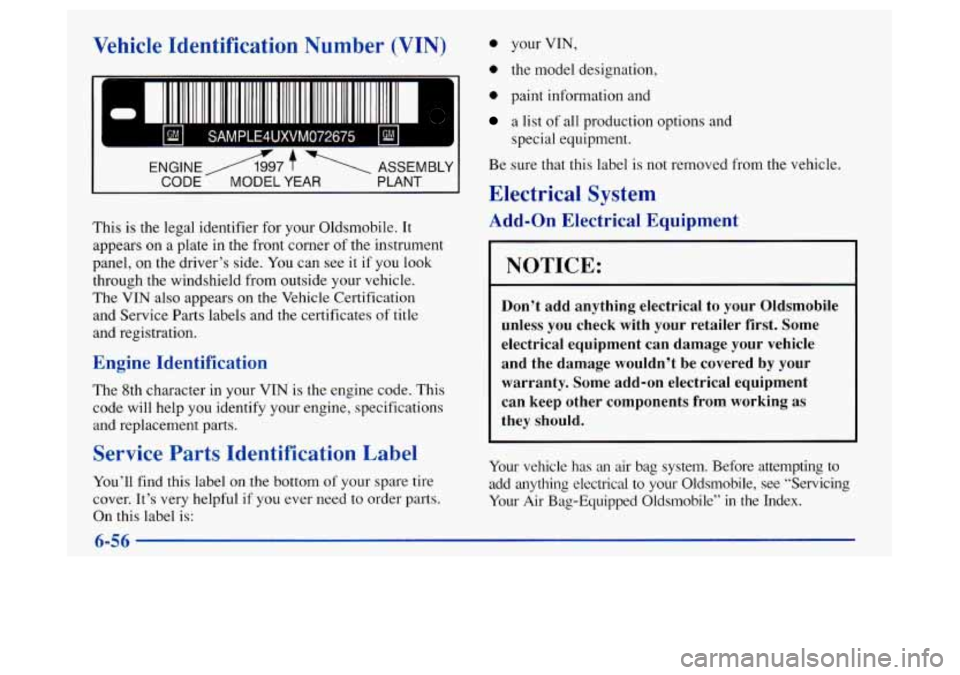
Vehicle Identification Number (VIN)
c
i
bl SAMPLE4UXVM072675 kd I1
This is the legal identifier for your Oldsmobile. It
appears on a plate in the front corner of the instrument
panel, on the driver’s side.
You can see it if you look
through the windshield from outside your vehicle.
The VIN also appears
on the Vehicle Certification
and Service Parts labels and the certificates
of title
and registration.
Engine Identification
The 8th character in your VIN is the engine code. This
code will help you identify your engine, specifications
and replacement parts.
Service Parts T -entification Label
You’ll find this label on the bottom of your spare. tire
cover. It’s very helpful
if you ever need to order parts.
On this label
is:
0 your VIN,
0 the model designation,
0 paint information and
a list of all production options and
special equipment.
Be sure that this label
is not removed from the vehicle.
Electrical System
Add-on Electrical Equipment
NOTICE: --
Don’t add anything electrical to your Oldsmobile
unless you check with your retailer first. Some
electrical equipment can damage your vehicle
and the damage wouldn’t be covered by your
warranty. Some add-on electrical equipment
can keep other components from working as
they should.
Your vehicle has an air bag system. Before attempting to
add anything electrical
to your Oldsmobile, see “Servicing
Your Air Bag-Equipped Oldsmobile”
in the Index.
Page 287 of 372

Headlamp Wiring
The headlamp wiring is protected by a circuit breaker in
the fuse block. An electrical overload will cause the
lamps to
go on and off, or in some cases to remain off.
If this happens, have your headlamp wiring checked
right away.
Windshield Wipers
The windshield wiper motor is protected by an internal
circuit breaker and a fuse.
If the motor overheats due to
heavy snow, etc., the wiper will stop until the motor
cools. If the overload
is caused by some electrical
problem and not snow, etc., be sure to get it fixed.
Power Windows and Other Power Options
Circuit breakers in the fuse panel protect the power
windows and other power accessories. When the current
load is
too heavy, the circuit breaker opens and closes,
protecting the circuit until the problem is fixed or
goes away.
Fuses and Circuit Breakers
The wiring circuits in your vehicle are protected from
short circuits by
a combination of fuses, circuit breakers
and fusible thermal links in the wiring itself. This
greatly reduces the chance
of fires caused by
electrical problems.
Look at the silver-colored band inside the fuse. If the
band is broken or melted, replace the fuse. Be sure you
replace a bad fuse with
a new one of the identical size
and rating.
If you ever have a problem on the road and don’t have
a spare fuse, you can “borrow” one that has the same
amperage. Just pick a feature of your vehicle that you
can get along without
-- like the radio or cigarette
lighter
-- and use its fuse, if it is the correct amperage.
Replace
it as soon as you can.
There are two fuse blocks in your vehicle: the
instrument panel fuse block
and the engine compartment
fuse block.
Page 290 of 372
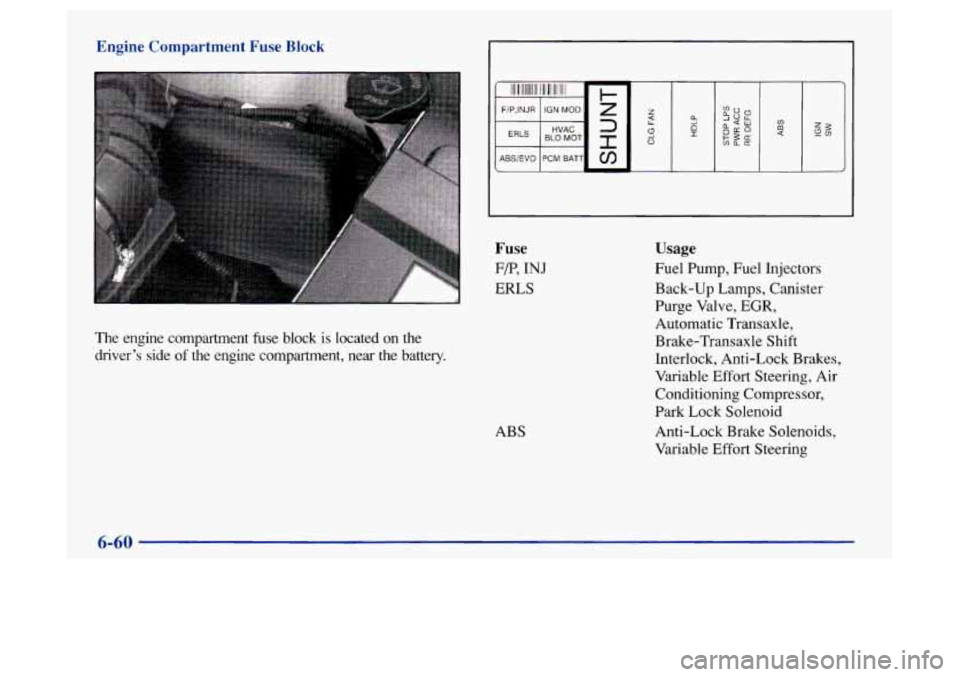
Engine Compartment Fuse Block
Fuse
F/P, INJ
ERLS
The engine compartment fuse block is located on the
driver’s side of the engine compartment, near the battery.
ABS
Usage
Fuel Pump, Fuel Injectors
Back-up Lamps, Canister
Purge Valve, EGR,
Automatic Transaxle,
Brake-Transaxle Shift
Interlock, Anti-Lock Brakes,
Variable Effort Steering, Air
Conditioning Compressor,
Park Lock Solenoid
Anti-Lock Brake Solenoids,
Variable Effort Steering
6-60
Page 291 of 372
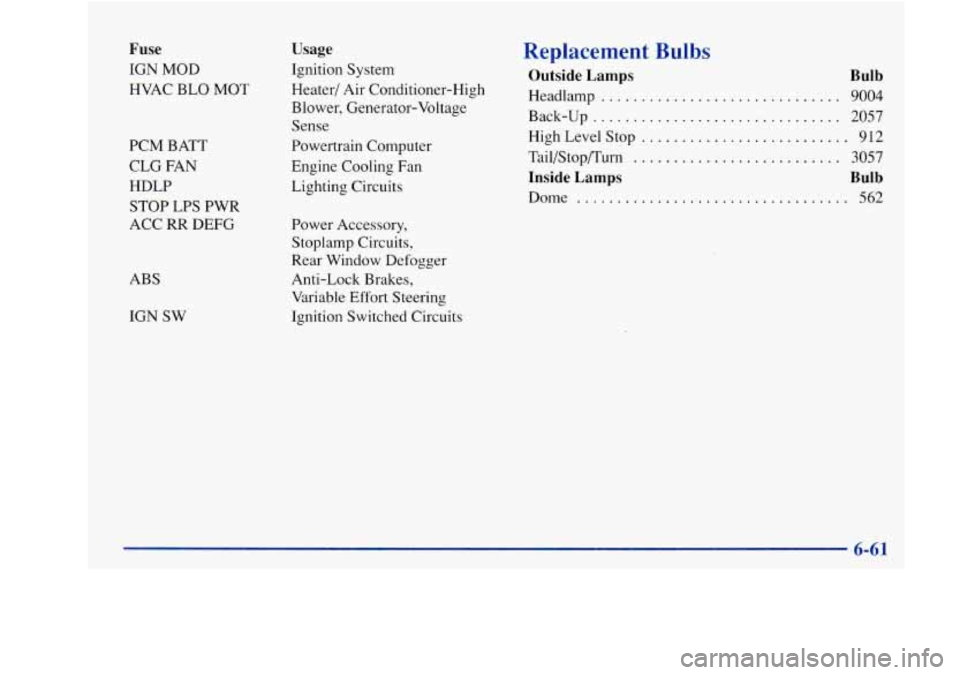
Fuse
IGN MOD
HVAC BLO MOT
PCM BATT
CLG FAN
HDLP
STOP
LPS PWR
ACC
RR DEFG
ABS
IGN SW
Usage
Ignition System
Heater/ Air Conditioner-High
Blower, Generator-Voltage
Sense
Powertrain Computer
Engine Cooling Fan
Lighting Circuits
Power Accessory,
Stoplamp Circuits,
Rear Window Defogger
Anti-Lock Brakes,
Variable
Effort Steering
Ignition Switched Circuits
Replacement Bulbs
Outside Lamps Bulb
Headlamp .............................. 9004
Back-up ............................... 2057
High Level Stop
.......................... 912
Tail/Stop/Turn
.......................... 3057
Inside Lamps Bulb
Dome .................................. 562
6-61
- . -
Page 292 of 372
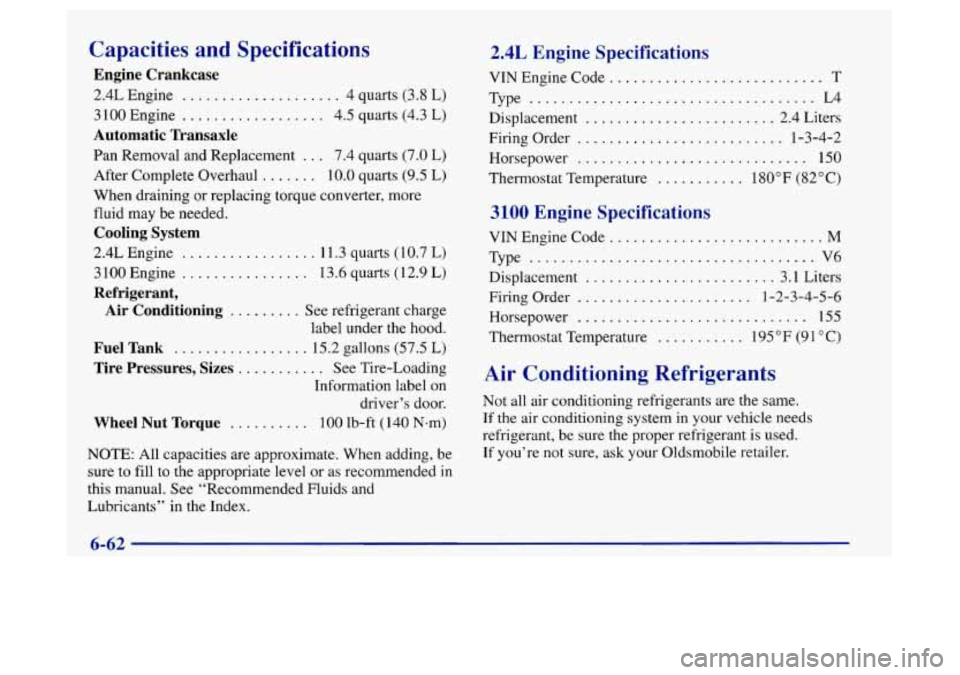
Capacities and Specifications
Engine Crankcase
2.4L Engine .................... 4 quarts (3.8 L)
3 100 Engine
.................. 4.5 quarts (4.3 L)
Automatic Transaxle
Pan Removal and Replacement ... 7.4 quarts (7.0 L)
After Complete Overhaul ....... 10.0 quarts (9.5 L)
When draining or replacing torque converter, more
fluid may be needed.
Cooling System
2.4LEngine ................. 11.3 quarts (10.7 L)
3100Engine
................ 13.6 quarts (12.9 L)
Refrigerant,
Air Conditioning
......... See refrigerant charge
label under the hood.
Fuel Tank ................. 15.2 gallons (57.5 L)
Tire Pressures, Sizes
........... See Tire-Loading
Information label on
driver’s door.
Wheel Nut Torque .......... 100 lb-ft (140 N-m)
NOTE: All capacities are approximate. When adding, be
sure to fill to the appropriate level or as recommended in
this manual. See “Recommended Fluids and
Lubricants” in the Index.
2.4L Engine Specifications
VINEngineCode ........................... T
Type .................................... L4
Displacement
........................ 2.4 Liters
Firing Order
.......................... 1-3-4-2
Thermostat Temperature
........... 180 OF (82 O C)
Horsepower ............................. 150
3100 Engine Specifications
VIN Engine Code ........................... M
Type .................................... V6
Displacement ........................ 3.1 Liters
Firing Order
...................... 1-2-3-4-5-6
Horsepower ............................. 155
Thermostat Temperature
........... 195°F (9 1 “C)
Air Conditioning Refrigerants
Not all air conditioning refrigerants are the same.
If the air conditioning system in your vehicle needs
refrigerant, be sure the proper refrigerant is used.
If you’re not sure, ask your Oldsmobile retailer.
6-62
Page 293 of 372
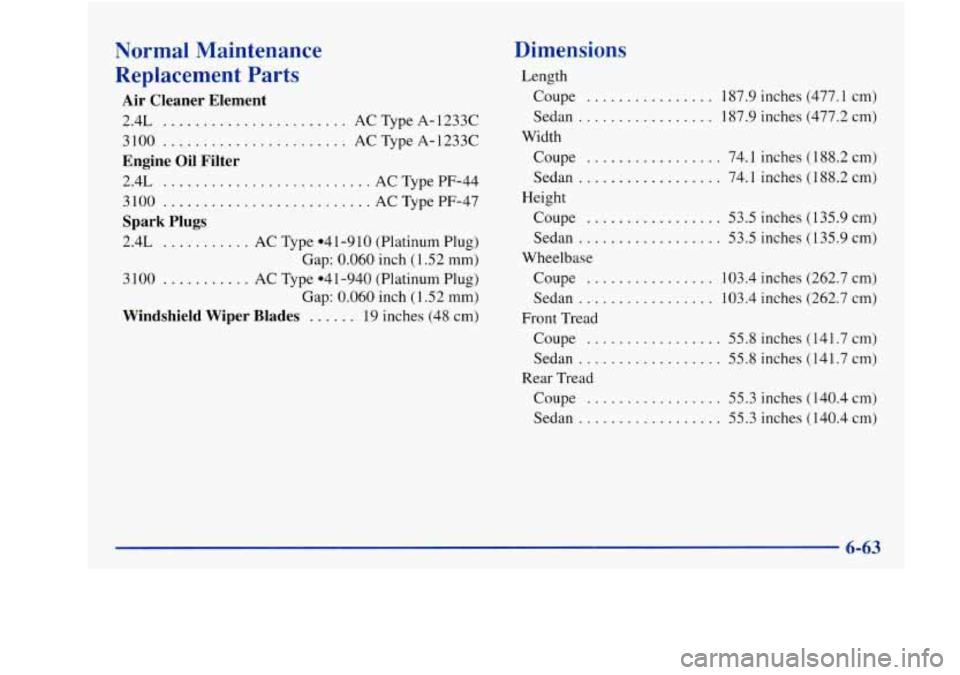
Normal Maintenance
Replacement Parts
Air Cleaner Element
2.4L ....................... AC Type A- 1233C
3100
....................... ACTypeA-1233C
Engine Oil Filter
2.4L .......................... AC Type PF-44
3100
.......................... ACTypePF-47
Spark Plugs
2.4L ........... AC Type 04 1-9 10 (Platinum Plug)
Gap:
0.060 inch (1.52 mm)
3 100
........... AC Type 041-940 (Platinum Plug)
Gap: 0.060 inch (1.52 mm)
Windshield Wiper Blades ...... 19 inches (48 cm)
Dimensions
Length
Coupe
................ 187.9 inches (477.1 cm)
Sedan
................. 1 87.9 inches (477.2 cm)
Coupe
................. 74.1 inches (188.2 cm)
Sedan
.................. 74.1 inches (188.2 cm)
Coupe
................. 53.5 inches (135.9 cm)
Sedan
.................. 53.5 inches (135.9 cm)
Coupe
................ 103.4 inches (262.7 cm)
Sedan
................. 103.4 inches (262.7 cm)
Coupe
................. 55.8 inches ( 14 1.7 cm)
Sedan
.................. 55.8 inches (141.7 cm)
Coupe
................. 55.3 inches ( 140.4 cm)
Sedan
.................. 55.3 inches (140.4 cm)
Width
Height Wheelbase
Front Tread
Rear Tread
Page 296 of 372
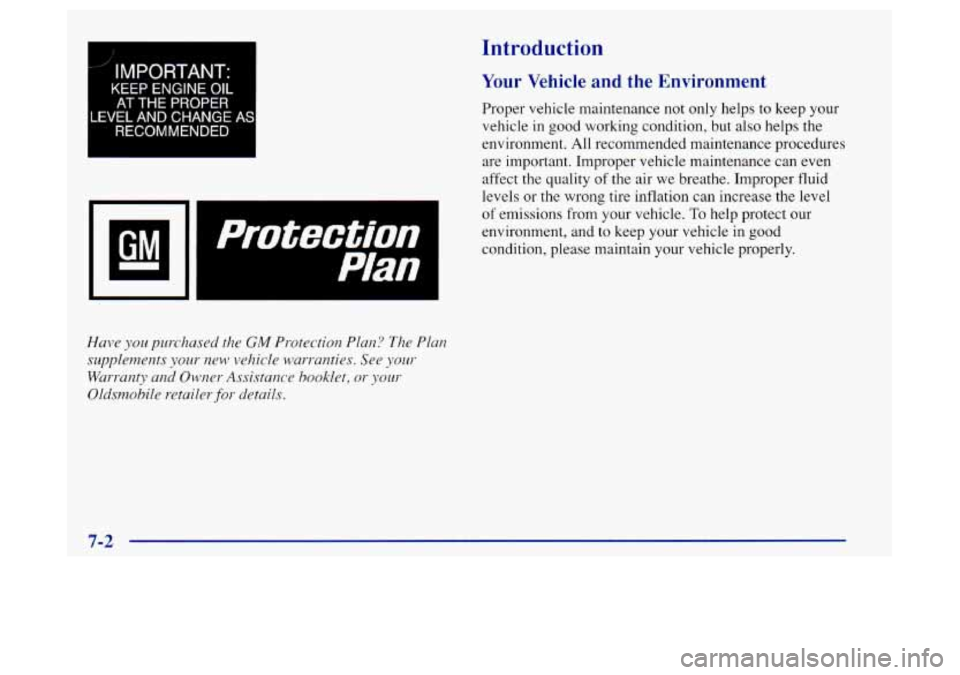
--” IMPORTANT.
KEEP ENGINE OIL
AT THE PROPER
LEVEL
AND CHANGE
RECOMMENDED
AS
I
Have you purchased the GM Protection Plan? The Plan
supplements your
new vehicle warranties. See your-
Warranty and Owner Assistance booklet, or
yoru-
Oldsmobile retailer- for details.
Introduction
Your Vehicle and the Environment
Proper vehicle maintenance not only helps to keep your
vehicle in good working condition, but also helps the
environment. All recommended maintenance procedures
are important. Improper vehicle maintenance can even
affect the quality
of the air we breathe. Improper fluid
levels or the wrong tire inflation can increase the level
of emissions from your vehicle.
To help protect our
environment, and to keep your vehicle
in good
condition, please maintain your vehicle properly.
7-2
Page 299 of 372
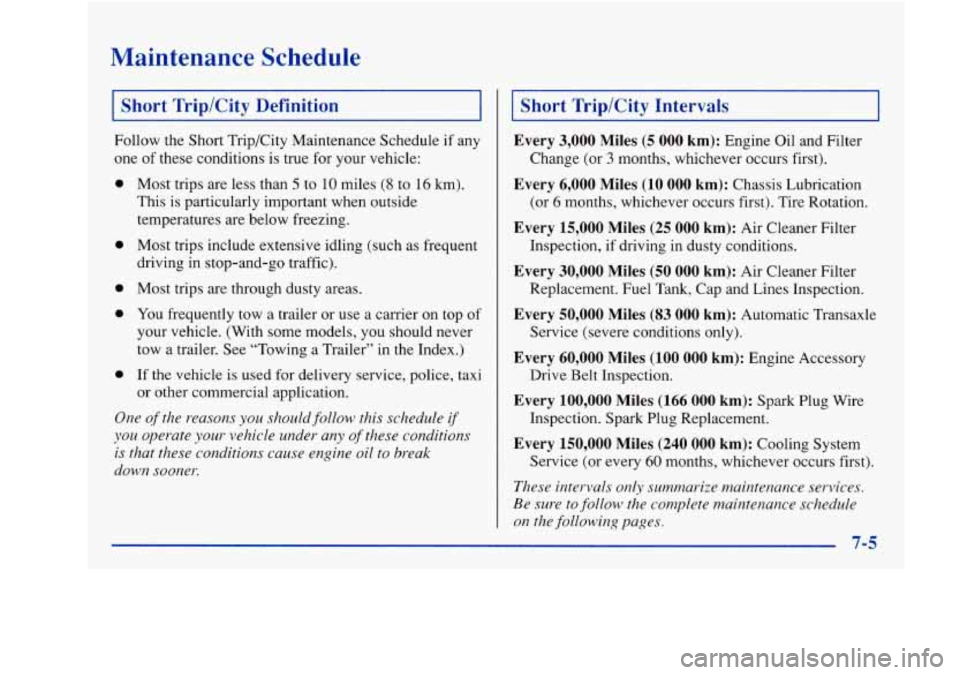
Maintenance Schedule
[ Short Trip/City Definition
Follow the Short Trip/City Maintenance Schedule if any
one
of these conditions is true for your vehicle:
0
0
0
0
0
Most trips are less than 5 to 10 miles (8 to 16 km).
This is particularly important when outside
temperatures are below freezing.
Most trips include extensive idling (such as frequent
driving in stop-and-go traffic).
Most trips
are through dusty areas.
You frequently tow a trailer or use a carrier on top of
your vehicle. (With some models, you should never
tow a trailer. See “Towing a Trailer” in the Index.)
If the vehicle is used for delivery service, police, taxi
or other commercial application.
One of the reasons you should follow this sch.edule if
you operate your vehicle under any
of these conditions
is
that these conditions cause engine oil to break
down sooner.
I i
I Short Trip/City Intervals
Every 3,000 Miles (5 000 km): Engine Oil and Filter
Every 6,000 Miles (10 000 km): Chassis Lubrication
Every 15,000 Miles (25 000 km): Air Cleaner Filter
Every 30,000 Miles (50 000 km): Air Cleaner Filter
Change
(or
3 months, whichever occurs first).
(or
6 months, whichever occurs first). Tire Rotation.
Inspection,
if driving in dusty conditions.
Replacement. Fuel Tank, Cap and Lines Inspection.
Every 50,000 Miles (83 000 km): Automatic Transaxle
Service (severe conditions only).
Every 60,000 Miles (100 000 km): Engine Accessory
Every 100,000 Miles (166 000 km): Spark Plug Wire
Every 150,000 Miles (240 000 km): Cooling System
These intervals only summarize maintenance services.
Be sure to
follow the complete maintenance schedule
on tlze,following pages.
Drive Belt Inspection.
Inspection. Spark Plug Replacement. Service (or every
60 months, whichever occurs first).
Page 300 of 372
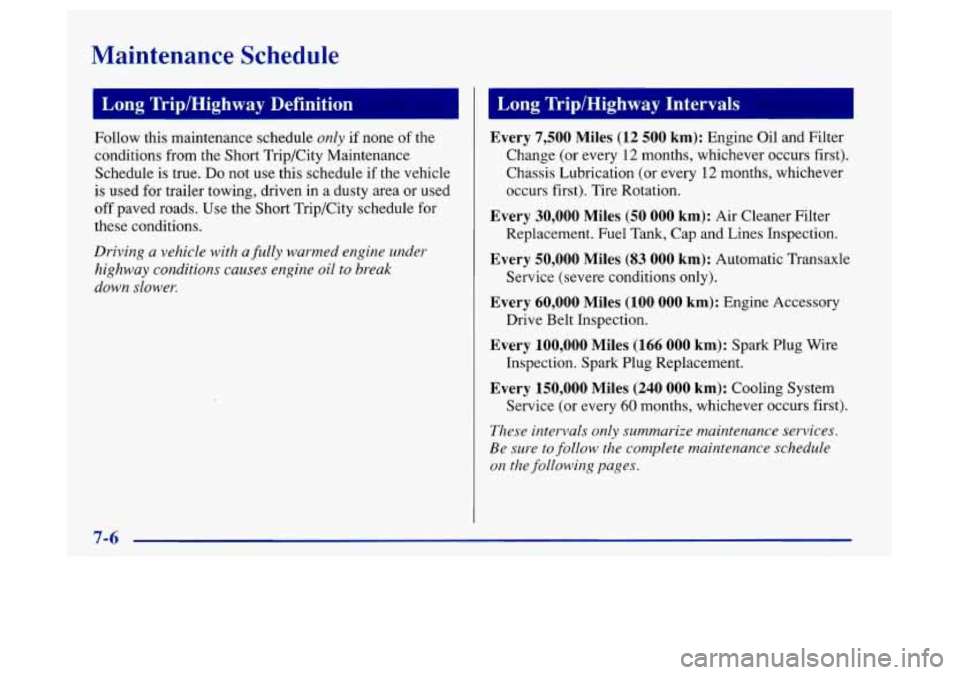
Maintenance Schedule
~~~~~~
I Long TriplHighway Definition
Follow this maintenance schedule only if none of the
conditions from the Short Trip/City Maintenance
Schedule is true.
Do not use this schedule if the vehicle
is used for trailer towing, driven in a dusty area or used
off paved roads. Use the
Short Trip/City schedule for
these conditions.
Driving a vehicle with a fully warmed engine under
highway conditions causes engine oil
to break
down slower.
I Long TrzH
Every 7,500 Miles (12 500 km): Engine Oil and Filter
Change (or every
12 months, whichever occurs first).
Chassis Lubrication (or every
12 months, whichever
occurs first). Tire Rotation.
Every 30,000 Miles (50 000 km): Air Cleaner Filter
Replacement. Fuel Tank, Cap and Lines Inspection.
Every 50,000 Miles (83 000 km): Automatic Transaxle
Service (severe conditions only).
Every 60,000 Miles (100 000 km): Engine Accessory
Every 100,000 Miles (166 000 km): Spark Plug Wire
Every 150,000 Miles (240 000 km): Cooling System
These intervals only summarize maintenance services.
Be sure
to follow the complete maintenance schedule
on the.foIlowing pages.
Drive Belt Inspection.
Inspection. Spark Plug Replacement.
Service (or every
60 months, whichever occurs first).
7-6
Page 302 of 372
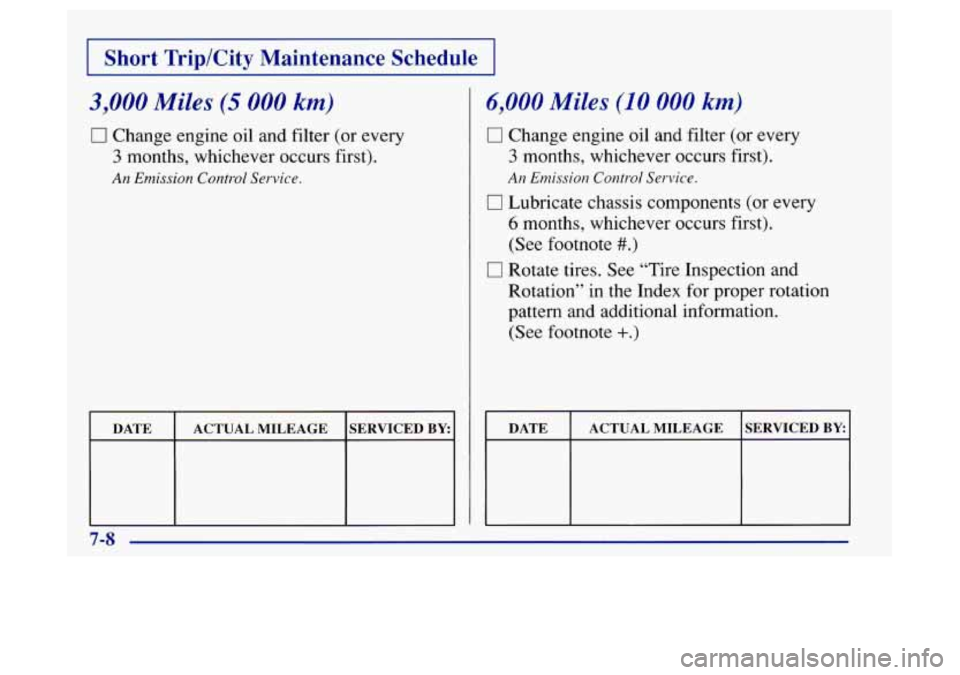
I Short Trip/City Maintenance Schedule I
3,000 Miles (5 000 km)
0 Change engine oil and filter (or every
3 months, whichever occurs first).
An Emission Control Service.
I DATE ACTUAL MILEAGE SERVICED BY:
6,000 Miles (10 000 km)
0 Change engine oil and filter (or every
3 months, whichever occurs first).
An Emission Control Service.
0 Lubricate chassis components (or every
6 months, whichever occurs first).
(See footnote
#.)
17 Rotate tires. See “Tire Inspection and
Rotation” in the Index for proper rotation
pattern and additional information.
(See footnote
+.)
DATE SERVICED BY ACTUAL
MILEAGE
7-8